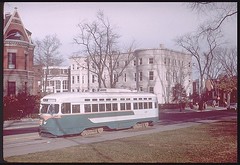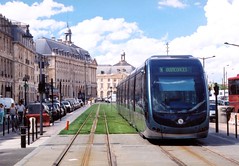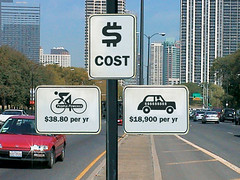Now here's a tradeoff I'd be willing to make
In that meeting I mentioned, one of the speakers is unwilling to accept a tradeoff of having streetcars with overhead catenary. In the "Old City," DC streetcars were powered from an underground electricty infrastructure. In fact a law required/requires it. Today, the technology isn't there to support electricity-based streetcar service without an overhead wire infrastructure.

Streetcar by Lincoln Park, DC, no wires. Joe Testagrose Collection.
I've mentioned that Alstom is testing an in-ground power system of their Citadis Light Rail system in Bordeaux, but it is experiencing teething problems. They haven't introduced it anywhere else.

Photo: Kenneth Sislak, DMJMHarris. No wires.
Frankly, I'd be happy to wait a couple years before launching streetcars in the DC region, if it'd be possible to go to in-ground powering. But I'm willing to have the streetcar system sooner at the price of the catenary. In Portland, it's doesn't look that bad...I think it's a reasonable tradeoff.

Portland streetcar at bulbout, allows parking. Click for a larger version and squint at the catenary. Photo by Laura Hall.
In today's Washington Post, columnist Robert Samuelson writes an amazing column," Seven Tough Choices We Will Not Make." He lists 7 great ideas, assuming "that Democrats and Republicans actually intended to address our dependence on foreign oil and our budget deficit."
Two I really like, one I don't, but the one I don't like, oil drilling in the Arctic Wildlife Refuge, I'd be willing to accept in return for the ones I really like (it's called "compromise"). Here goes:
• Enact an energy tax equivalent to $2 a gallon on gasoline -- introduced over six years, or about 33 cents annually. The purpose: to increase tax revenue and induce Americans to buy more fuel-efficient vehicles.
• Raise federal fuel-efficiency standards for cars from the present 27.5 miles per gallon to 40 mpg by 2020 and make similar increases for light trucks and SUVs. If fuel-efficient vehicles are to be favored, they must be available.
• Open the Arctic National Wildlife Refuge to oil production. This would help offset declining U.S. output elsewhere.

Kimberly Viviano, Viviano + Company. "People Powered." The Big Idea: A system of signs posted along Chicago's lakefront would inform drivers and bicyclists of the human, financial, and environmental benefits of riding a bike to work versus driving a car. From Metropolis Magazine.
Index Keywords: energy; transit



0 Comments:
Post a Comment
<< Home